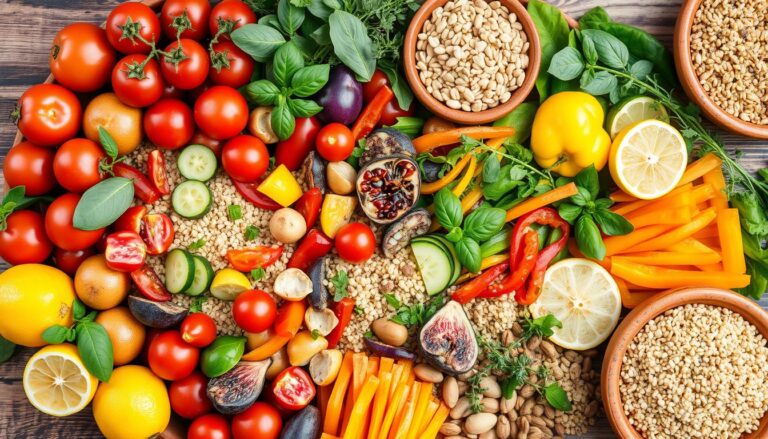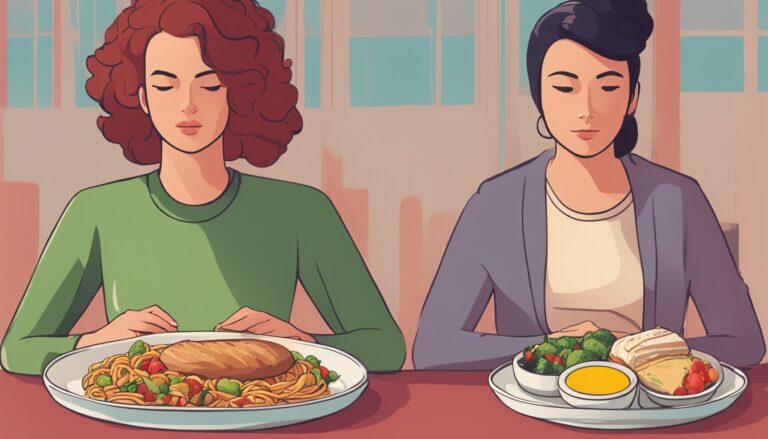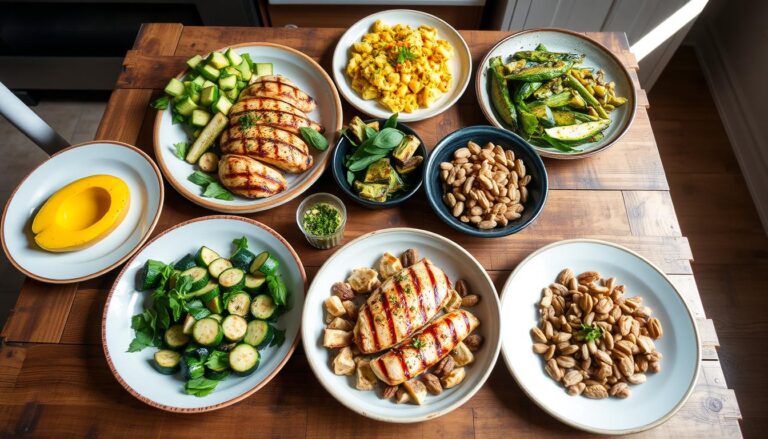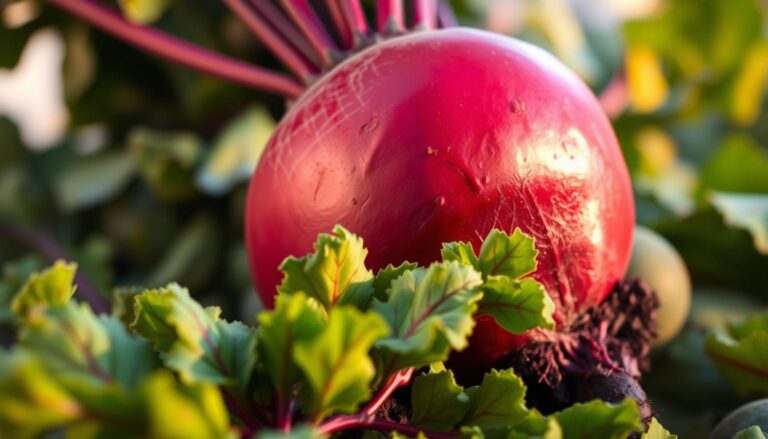For years we’ve debated is it better to get protein from meat or beans? Let’s finally settle this debate and explore the surprising facts about these foods.
Are you ready to learn about the protein in meat and beans?
Key Takeaways
- One serving 1/2 cup cooked of beans provides about 7 grams of protein equivalent to 1 ounce of meat.
- Beans are a fiber rich protein-packed superfood that can offer a cost-effective and healthy alternative to meat.
- Incorporating more plant based proteins like beans into your diet can provide a range of health benefits, from aiding weight loss to lowering cholesterol.
- Meat, poultry fish, and other animal-based proteins offer a variety of protein sources each with their own unique nutritional profiles.
- Balancing your protein intake from both plant-based and animal-based sources can help you achieve optimal health and fitness goals.
Comparing Protein Content Beans vs. Meat
The debate between bean based protein and meat-based protein has been ongoing. A study from the University of Copenhagen has shed light on how these proteins affect satiety and calorie intake.
The study showed that bean-based meals with 19% protein made people eat 12% fewer calories later. This means bean based meals kept people fuller longer than meat-based meals. The high fiber in bean based meals helps with weight loss and staying healthy.
Protein-Packed Beans vs. Meat
Beans and meat are both great for protein. But they are very different in what they offer nutrition-wise. Here’s a look at their protein content:
- 3 ounces of chicken breast has about 26 grams of protein.
- 4 ounces of steak gives you around 40 grams of protein.
- 1.5 cups of black beans have 22.5 grams of protein.
- 1 cup of lentils has about 27 grams of protein.
This shows how beans and lentils are packed with protein. They’re great alternatives to meat-based proteins.
Transitioning half of animal-based meals to a vegan diet could lead to a 35% reduction in overall greenhouse gas emissions.
Looking at the environmental impact of meat production is important when comparing bean-based and meat-based proteins. Eating more plant-based proteins like beans helps the planet and gives you the benefits of a fiber-rich, protein-packed superfood.
Protein Sources: Meats Poultry, and Fish
Animal based protein offers a wide range of choices. You can enjoy the rich flavors of beef chicken and turkey. Or you can try the delicate textures of fish and seafood. Each has its own protein content, making it important to know them for a balanced diet.
Protein-Packed Meats
A 3-ounce serving of lean beef is packed with 24.6 grams of protein. Half a chicken breast gives you 26.7 grams. Pork and lamb also offer a lot of protein with about 25 grams per 3-ounce serving.
Seafood Sensations
The ocean is full of protein-rich seafood. Salmon gives you 30.5 grams of protein in a 3-ounce serving. Clams offer 21.8 grams. Even canned tuna is a good choice with 19 grams of protein per 100 grams.
Poultry Powerhouses
Chicken and turkey are top choices for lean, high-protein poultry. A 3-ounce turkey breast has 25.6 grams of protein. Chicken breast gives you 32 grams. Choosing skinless options keeps the protein high and fat low.
| Protein Source | Protein Content per 100g |
|---|---|
| Chicken Breast Skinless, Cooked | 32g |
| Turkey Breast Skinless, Roasted | 30g |
| Beef Roast Roasted | 28g |
| Pork Roast Roasted | 27g |
| Ground Beef Cooked | 26g |
| Salmon Baked or Broiled | 25g |
| Halibut Cooked Dry Heat | 23g |
| Tilapia Cooked Dry Heat | 26g |
| Cod Cooked | 20g |
| Pollock Cooked | 19g |
| Canned Tuna Light in Water | 19g |
| Shrimp Baked or Broiled | 17g |
Adding lean meats poultry and seafood to your diet ensures you get the high-quality protein your body needs.

Plant Based Protein Powerhouses
Many think of animal products when they hear about high protein foods. But the plant world has its own strong protein sources. Foods like soy legumes nuts, and seeds are great meat alternatives. They give you important nutrients without the downsides of too much animal protein.
Soy Based Marvels
Soy foods like tofu tempeh, and edamame are packed with protein. A cup of cooked tofu has 20 grams of protein. Tempeh and edamame give you 34 grams and 18 grams per cup respectively. These foods are easy to add to many dishes making them a smart choice for cutting down on animal protein.
Legume Legends
Legumes such as lentils chickpeas, and beans are full of protein. A cup of cooked lentils has about 18 grams of protein. Chickpeas offer 15 grams per cup. These foods are also high in fiber, making them great for a balanced diet.
Nut and Seed Superstars
Nuts and seeds are great for getting plant-based protein. For example three tablespoons of hemp hearts have 10 grams of protein. A quarter-cup of pistachios gives you 6 grams. These foods are easy to add to your diet and offer many health benefits.
Adding different plant based proteins to your meals helps you meet your protein needs. It also increases fiber healthy fats, and lowers environmental impact compared to animal proteins. Try out plant-based protein sources to nourish your body and improve your health.
| Food | Protein g per Serving |
|---|---|
| Tempeh 1 cup cooked | 34 g |
| Tofu 1 cup cooked | 20 g |
| Edamame 1 cup cooked | 18 g |
| Lentils 1 cup cooked | 18 g |
| Chickpeas 1 cup cooked | 15 g |
| Hemp hearts 3 tbsp | 10 g |
| Pistachios 1/4 cup | 6 g |
Beans A Fiber Rich Protein Packed Superfood
Beans and legumes are top choices for plant-based protein. They are superfoods that offer a lot of protein, similar to many animal proteins.
A half-cup of cooked beans gives you 7 to 9 grams of protein. This makes them a great addition to any meal. They are also full of fiber with up to 15 grams in one serving.
Beans are packed with fiber and protein. This makes them a nutrient-rich and filling food. Eating beans regularly can help with weight loss, lower cholesterol control blood sugar and reduce heart disease and cancer risk.
Beans are a true superfood that should be in every healthy diet. They are versatile and can be added to many dishes. From soups and stews to dips and main courses beans are a great choice.
| Legume | Protein g/1/2 cup cooked | Fiber g/1/2 cup cooked |
|---|---|---|
| Chickpeas Garbanzo Beans | 7.3 | 6.3 |
| Lentils | 9.0 | 7.8 |
| Green Peas | 4.3 | 4.4 |
| Kidney Beans | 7.7 | 6.6 |
| Black Beans | 7.6 | 7.5 |
| Soybeans | 15.7 | 5.2 |
| Pinto Beans | 7.7 | 7.7 |
Beans are amazing because of their protein and fiber. They also have vitamins minerals and antioxidants. This makes them a superfood that should be in every healthy diet.
Nutritional Benefits of Beans Beyond Protein
Beans are more than just a good source of protein. They are packed with health benefits that make them a superfood. These benefits include aiding in weight loss lowering cholesterol, and controlling blood sugar. They are a nutritional powerhouse.
Weight Loss and Satiety
Research shows that eating bean-based proteins can lead to eating 12% fewer calories later. This is because beans are high in fiber. Fiber makes you feel full and satisfied.
Cholesterol and Heart Health
Beans are great for your heart. They help lower cholesterol and reduce the risk of heart disease. The fiber in beans helps remove cholesterol from your body. This can lower the risk of blockages and improve heart health.
Blood Sugar Control
If you’re watching your blood sugar, beans can help. They have protein, fiber, and complex carbs that slow down sugar absorption. This prevents blood sugar spikes and dips.
Gut Health and the Microbiome
Beans are good for your gut microbiome because they are high in fiber. This fiber feeds the good bacteria in your gut. It helps with digestion and boosts your immune system.
Adding more beans to your meals can bring many health benefits. They help with weight loss, heart health, and gut function. These legumes are a nutritional powerhouse.
Versatile Bean Recipes for Every Meal
Beans are a superfood full of protein fiber and essential nutrients. They can be added to many tasty dishes like dips soups wraps and burritos. Discover how to make your meals better with these creative bean recipes.
Beantastic Breakfast and Brunch
Start your day with a protein packed breakfast. Try our Garbanzo Chocolate Cookies or a savory Breakfast Bean Burrito with eggs, black beans and your favorite toppings. For a snack make a creamy Curry Hummus Dip with chickpeas and spices.
Bountiful Bean Based Lunches and Dinners
Beans are great for making hearty, protein rich meals. Enjoy a bowl of Lentil and White Bean Soup or a fresh Spinach Chickpea and Quinoa Salad. For dinner have our tasty Red Beans Vegan Chili or a warm Masala Rice Pilaf With Hyacinth Beans.
| Recipe | Protein g | Fiber g | Other Nutrients |
|---|---|---|---|
| Vegan Black Bean Tacos | 12.8 | 11.5 | – |
| Simple Green Bean and Potato Curry | 7 | 8 | 63 mg vitamin C, 3 mg iron |
| Instant Pot Pinto Beans With Chorizo | 14 | 8 | 0.33 mg thiamin |
| Greek-Style Black-Eyed Peas Stew | 9.3 | 9.6 | 105 mcg folate |
| Kidney Bean and Chickpea Salad | 7 | 6 | 3.7 mg iron, 1.8 mg zinc |
Beans are versatile and can be used in many dishes. From soups and stews to dips and wraps they add protein and flavor to any meal. Make them a key ingredient in your kitchen.
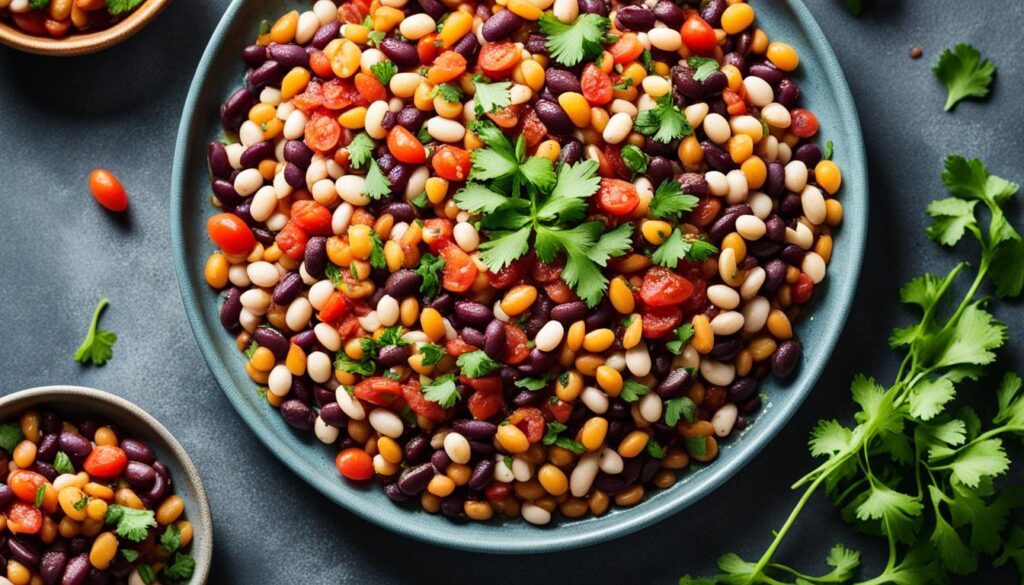
Read more: High Protein Diets Focus on Protein in Food
How much protein is in meat and beans?
Meat and beans are great for getting protein, but the amount varies. A 1-ounce serving of lean meats like beef chicken or pork has about 7 grams of protein. On the other hand, a 1/2 cup of cooked beans gives you 7-9 grams of protein.
Beans and legumes are great for plant-based protein and are high in fiber. This fiber helps you feel full and can help with weight management. In contrast meat is a concentrated protein source. A 3-ounce serving of lean beef has less than 180 calories and gives you 25 grams of protein.
| Protein Source | Protein Content per serving |
|---|---|
| Lean Beef 3 oz | 25 grams |
| Beans 1/2 cup cooked | 7-9 grams |
| Chicken Breast 3 oz | 26 grams |
| Pork Loin 3 oz | 22 grams |
Both meat and beans are excellent for getting protein. The choice depends on what you like, your dietary needs, and your health goals. By eating a mix of animal and plant-based proteins you can get the right amount of protein for a healthy diet.
Environmental Impact Beans vs. Meat
The world’s population is growing, and so is the need for protein-rich foods. But meat production’s environmental impact is a big problem. Choosing plant-based proteins like beans over meat can greatly help the environment.
Beef production needs a lot of land and creates a lot of greenhouse gases. It uses 20 times more land and emits 20 times more greenhouse gases than beans peas and lentils. Chicken and pork are also bad for the environment needing three times more land and emitting three times more greenhouse gases than beans. Plus, beef uses one-third of the world’s water for farm animals.
The numbers show that meat production is bad for the planet. Eating more beans and legumes can make us healthier and help the planet. In fact eating less meat and dairy could cut the average American’s environmental impact by nearly half.
Sustainable Diet Choices
Choosing sustainable diets can make a big difference. If we eat less meat and dairy, we could save a lot of land and reduce greenhouse gas emissions. This could spare 310 to 640 million hectares of land and cut greenhouse gas emissions by up to 168 billion tons of CO2 equivalent.
Choosing plant-based proteins such as beans, over meat can have a substantial positive impact on the environment.
It’s clear that eating plant based proteins like beans instead of meat helps the environment. This choice is good for our health and the planet. It’s a win-win situation.
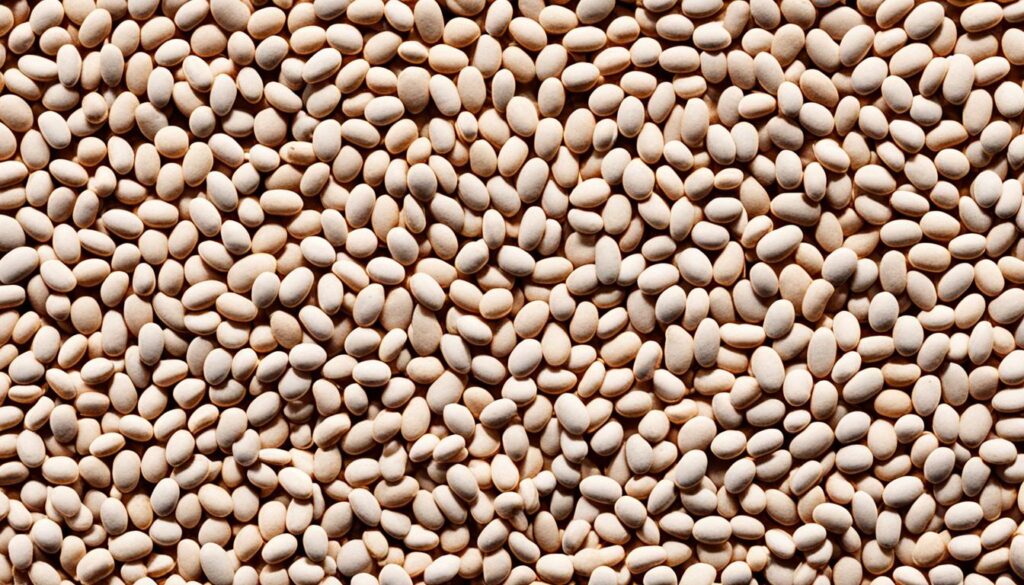
Achieving Optimal Protein Intake
Getting enough protein is key for good health and important body functions. The daily protein intake for adults is about 0.8 grams per kilogram of body weight. This means around 54 grams a day for a 150-pound person.
Some experts say you might need more protein, like 0.9 grams per kilogram, if you eat a lot of plants. Your protein needs can change based on your age, how active you are, and your health.
Meeting Your Protein Needs
To get enough protein, eat a mix of foods high in protein from animals and plants. Great options include:
- Lean meats, poultry, and fish
- Legumes, nuts, and seeds
- Dairy products, such as milk, yogurt, and cheese
- Soy-based foods, like tofu and tempeh
- Eggs
- Quinoa
By eating different protein sources, your diet will be rich in protein and full of important nutrients.
| Age Group | Recommended Daily Protein Intake |
|---|---|
| Babies | 10 grams |
| School-age Children | 19-34 grams |
| Teens Assigned Male at Birth | Up to 52 grams |
| Teens Assigned Female at Birth | 46 grams |
| Adults Assigned Male at Birth | 56 grams |
| Adults Assigned Female at Birth | 46 grams 71 grams if pregnant or breastfeeding |
| Older Adults | 1.0-1.2 grams per kilogram of body weight |
Follow these guidelines and eat a balanced diet with regular exercise. This helps you get the right amount of protein for good health and well-being.
Conclusion
This article looked at the protein in meat and beans, showing they’re both great for nutrition. Meat is often seen as the top protein source. But beans and other plant proteins can match or even beat it in protein content. They also add fiber, vitamins, and minerals.
Adding both animal and plant proteins to your diet helps meet your protein needs. It also brings together the best of both worlds nutritionally. This article has given a detailed look at the protein and health benefits of meat and beans. It helps readers make smart choices for their protein intake.
It doesn’t matter if you love meat or prefer plants. The goal is to find a balance that fits your lifestyle and tastes. With some creativity and an eye for nutrition, you can mix meat and beans into meals that are tasty and good for you.

